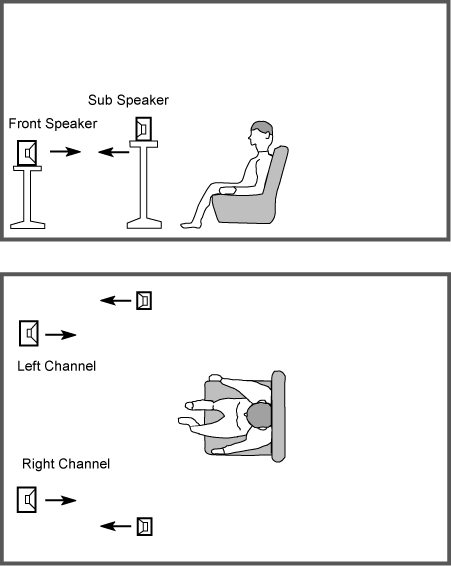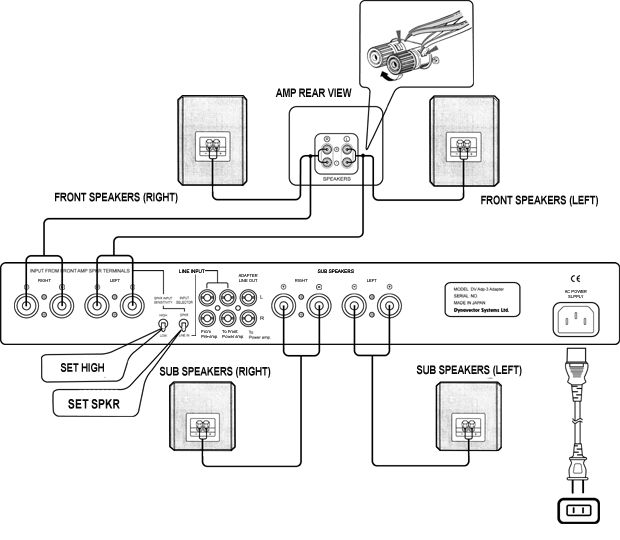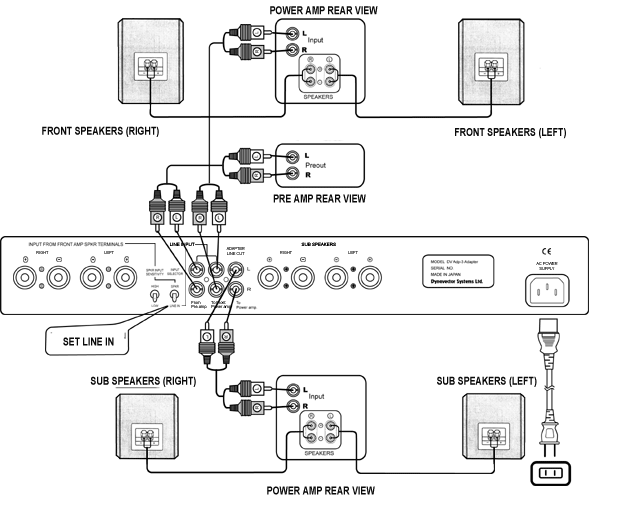Installation Methods for DV SS ADP-3
Sub-speakers and Speaker Positioning
Your existing audio system can be equipped to produce SuperStereo sound very easily.
Your existing audio system can easily be transformed to a SuperStereo system by simply adding the ADP-3 and a pair of small speakers to your audio system. The set-up of the ADP-3 is quite straightforward and does not require elaborate adjustments, unlike a 5.1 surround sound system.
Choice of Speakers
(1) Front speakersYour existing front speakers should work well in a SuperStereo system. If you intend to replace your front speakers however, high-performance and smaller size units will give a good SuperStereo performance. Your existing front speakers should work well in a SuperStereo system.
(2) Sub-SpeakersSmall speakers with 10-13cm main drive unit are recommended even if large speakers are used for the front speakers. Large speakers are best not used for sub-speakers as the sound will then tend to be rather bloated or boomy and lack definition. The sealed box type of sub-speaker often gives better results having the advantage that they are acoustically less sensitive to positioning near to room boundaries. However, the bass reflex type will usually also work well and advantage can sometimes be had by using felt to plug the port.
Speaker Positioning
The recommended listening position is behind the line joining the 2 sub speakers. Most positions behind the line are likely to be fine thus enabling a number of listeners to enjoy the benefits of SuperStereo sound. It is best if the distance between the left and right sub-speakers is rather greater than that of the front speakers and, as previously mentioned, the sub-speakers should be located face-on to the front speakers.

Connection of the ADP-3 to a with an Integrated Amplifier
Keep the existing connections between your amplifier and front speakers. Then, using speaker cables of appropriate length, connect one end to the speaker output terminals of your existing amplifier and the other end to the input terminals of the ADP-3, taking care to observe the correct polarities.
Using speaker cable, connect the sub-speaker output terminal of the ADP-3 to the sub-speakers, observing the correct polarities.

When Using a Separate Pre and Power Amplifier
Where the pre-amplifier has 2 sets of output terminals, use one set to connect it to the power amplifier for the front speakers using the usual RCA phono inter-connects. Then use the second set of output terminals with similar inter-connects to connect the pre-amp to the Line Input terminal of the ADP-3.
Where the pre-amplifier has only one set of outputs, connect the output to the Line Input Terminal of the ADP-3 and the Line Input Terminal to the power amplifier to provide the signal for the front speakers.
Using speaker cable, connect the sub-speakers to the ADP-3 Sub-Speaker Terminals observing the correct polarities.
 When greater power is required for the sub-speakers.
When greater power is required for the sub-speakers.In this case you should use an extra power amplifier to drive the sub-speakers which has sufficient power to give the volume required in a large room, or for entertainment functions and similar events.
Using the usual RCA phono equipped inter-connects, connect the input of the extra power amplifier to the Line Output terminals of the ADP-3.
Using speaker cable, connect the sub-speakers to the speaker terminals of the extra power amplifier.

